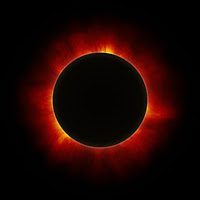Air & Space: Are You Ready for the 2017 Solar Eclipse?
The 2017 total solar eclipse has been generating a lot of excitement! On August 21, 2017, we'll be treated to the first total solar eclipse in the continental U.S. in 38 years.
Per NASA, an eclipse is a special type of transit where one planet passes in front of another. For the total solar eclipse, the moon will completely block the sun, leaving its atmosphere, the corona, shining around the perimeter.
Everyone in the country will be able to see at least a partial eclipse. The path of totality will range from Madras, Oregon to Columbia, South Carolina. The time of the eclipse depends on where you live, but starts at 9:06 AM Pacific Time in Oregon and ends at 4:06 Eastern Time in South Carolina. Totality only lasts 2 - 3 minutes, but the eclipse from start to finish lasts about 2 1/2 to 3 hours in the path of totality.
If you want to watch the eclipse, heed the safety requirement and wear solar eclipse glasses. You may be able to get a pair for free at libraries or events. Or you can purchase them. Make sure they are from a reputable supplier, meet the ISO 12312-2 international safety standard, and are from a reputable supplier. NASA has a list of reputable vendors for solar glasses. Looking directly at the sun, even during an eclipse, can cause permanent eye damage. If you're all prepared to watch the eclipse and it's cloudy (which would be my luck), there are live streaming events at libraries, museums, and online. By the way, the National Weather Service has a page for the 2017 Total Eclipse also, with climate information and forecasts as the date gets closer.
NASA has a special section on their website for the 2017 Total Eclipse, and it's outstanding. Their site includes information about scientific aspects of the eclipse; ways to view the eclipse safely; events; activities, and education. There's even an interactive map where you can click to see the details of the eclipse at your location.
If you want to enjoy the eclipse in the wide outdoors, the National Park Service has a map of National Parks in the path of totality, and makes some planning recommendations.
If you plan to film or photograph the eclipse, check on the Eclipse Megamovie Project. This is a citizen science project to gather data on the eclipse. Or you can share your photos with NASA through their 2017 Eclipse Flickr Gallery. Or you can engage in one of the other citizen science projects. You can even help NASA record temperatures during the eclipse as part of the GLOBE project.
The 2017 eclipse even has its own Facebook Page!
If you really get into it, you can purchase a solar eclipse shirt, hat, or even your own telescope! So get out and enjoy this rare event!
Per NASA, an eclipse is a special type of transit where one planet passes in front of another. For the total solar eclipse, the moon will completely block the sun, leaving its atmosphere, the corona, shining around the perimeter.
Everyone in the country will be able to see at least a partial eclipse. The path of totality will range from Madras, Oregon to Columbia, South Carolina. The time of the eclipse depends on where you live, but starts at 9:06 AM Pacific Time in Oregon and ends at 4:06 Eastern Time in South Carolina. Totality only lasts 2 - 3 minutes, but the eclipse from start to finish lasts about 2 1/2 to 3 hours in the path of totality.
If you want to watch the eclipse, heed the safety requirement and wear solar eclipse glasses. You may be able to get a pair for free at libraries or events. Or you can purchase them. Make sure they are from a reputable supplier, meet the ISO 12312-2 international safety standard, and are from a reputable supplier. NASA has a list of reputable vendors for solar glasses. Looking directly at the sun, even during an eclipse, can cause permanent eye damage. If you're all prepared to watch the eclipse and it's cloudy (which would be my luck), there are live streaming events at libraries, museums, and online. By the way, the National Weather Service has a page for the 2017 Total Eclipse also, with climate information and forecasts as the date gets closer.
NASA has a special section on their website for the 2017 Total Eclipse, and it's outstanding. Their site includes information about scientific aspects of the eclipse; ways to view the eclipse safely; events; activities, and education. There's even an interactive map where you can click to see the details of the eclipse at your location.
If you want to enjoy the eclipse in the wide outdoors, the National Park Service has a map of National Parks in the path of totality, and makes some planning recommendations.
If you plan to film or photograph the eclipse, check on the Eclipse Megamovie Project. This is a citizen science project to gather data on the eclipse. Or you can share your photos with NASA through their 2017 Eclipse Flickr Gallery. Or you can engage in one of the other citizen science projects. You can even help NASA record temperatures during the eclipse as part of the GLOBE project.
The 2017 eclipse even has its own Facebook Page!
If you really get into it, you can purchase a solar eclipse shirt, hat, or even your own telescope! So get out and enjoy this rare event!




Comments
Post a Comment